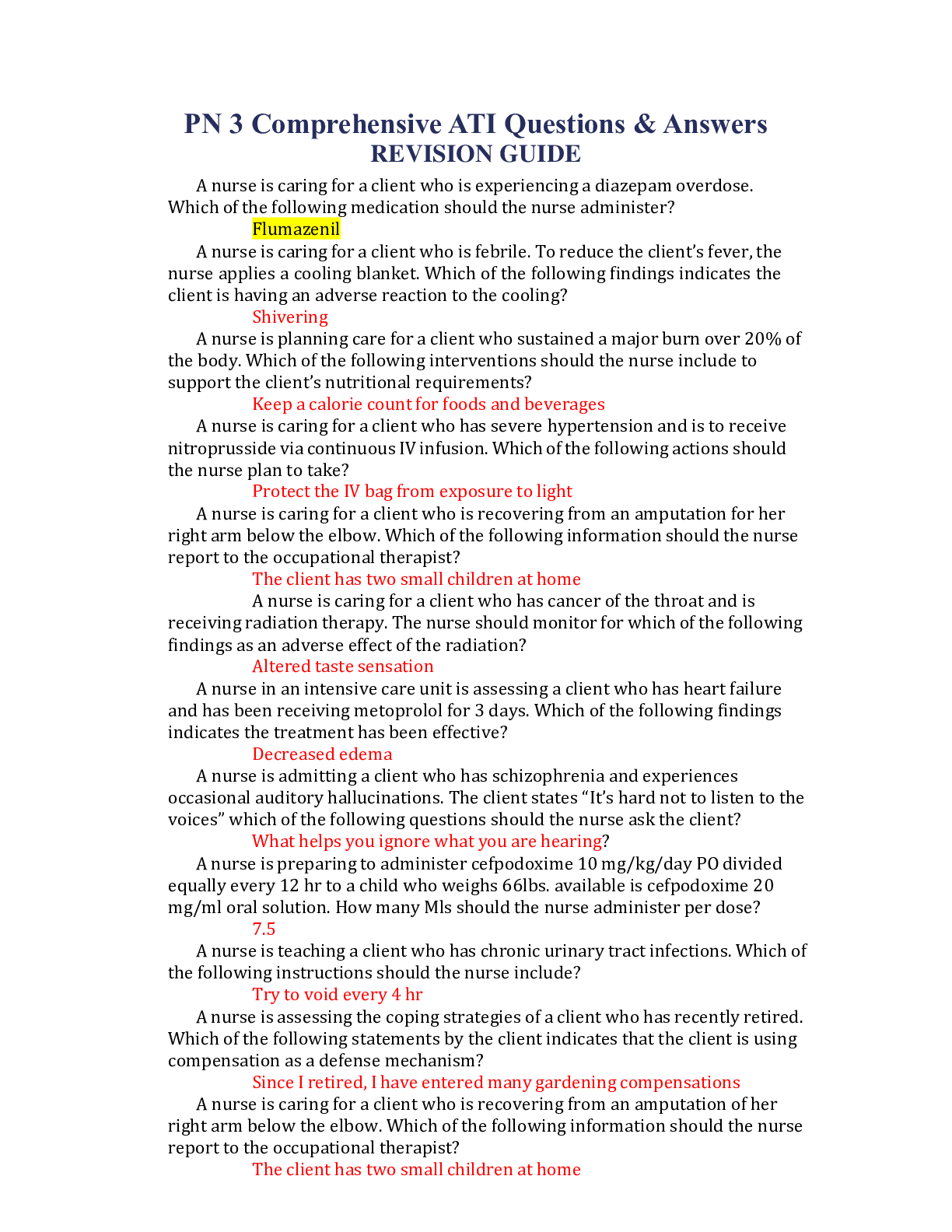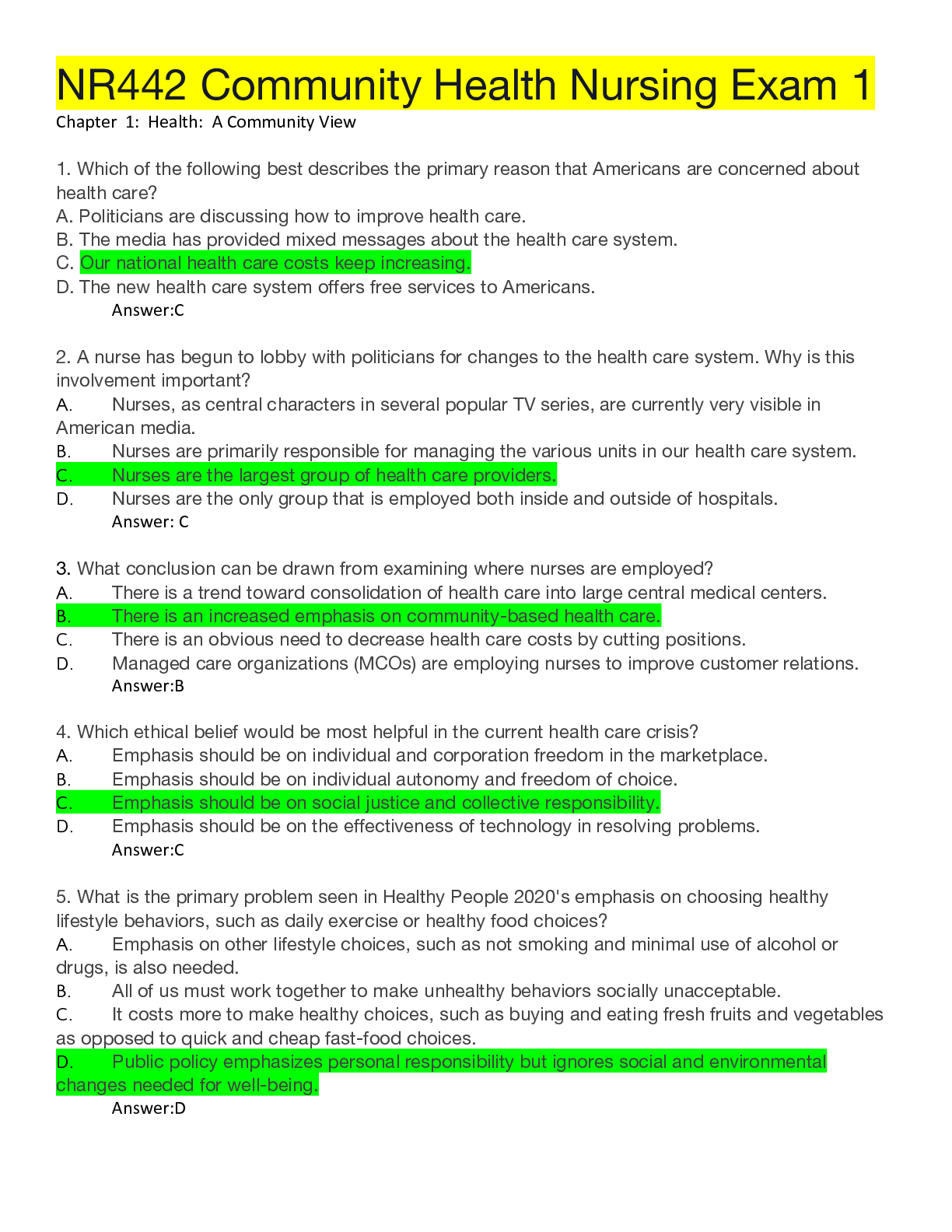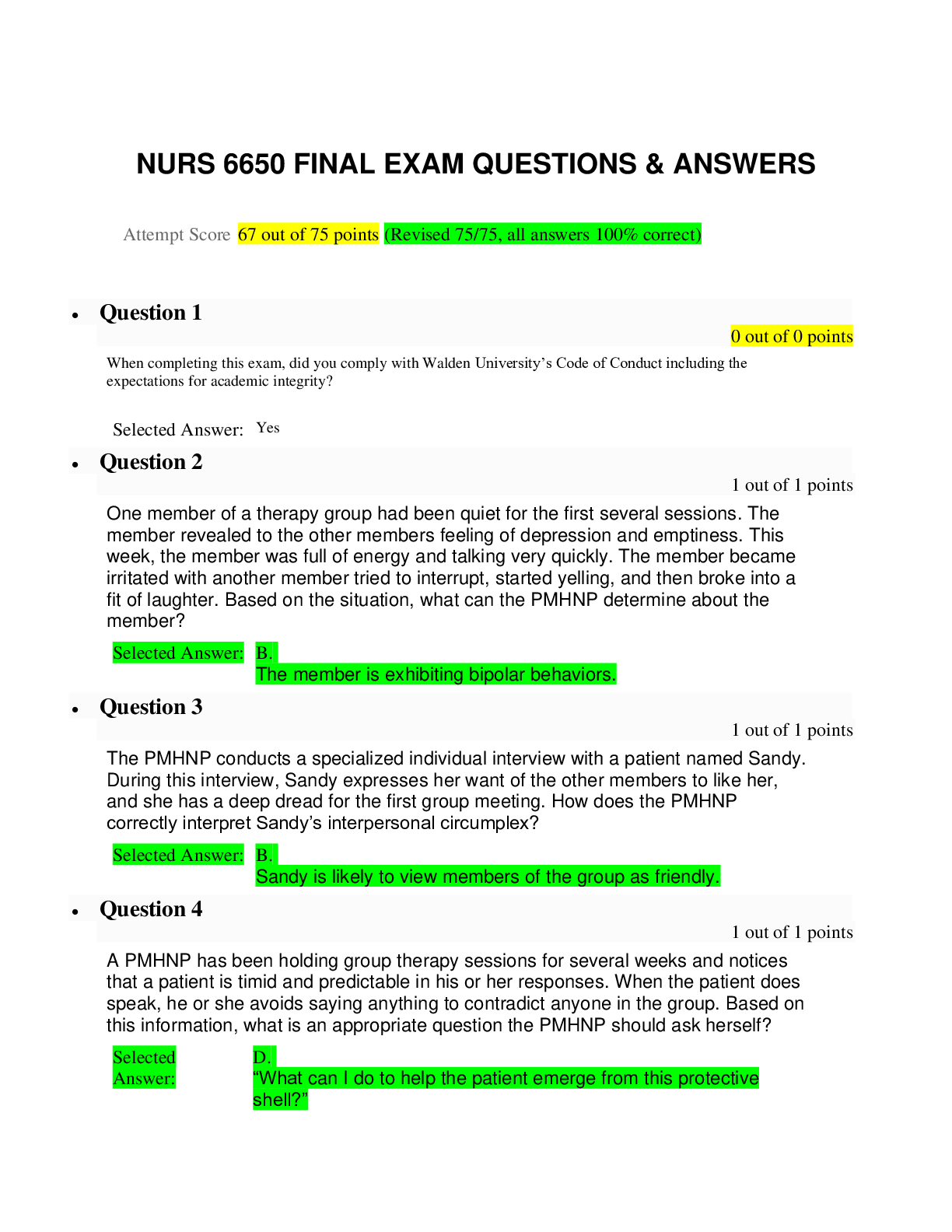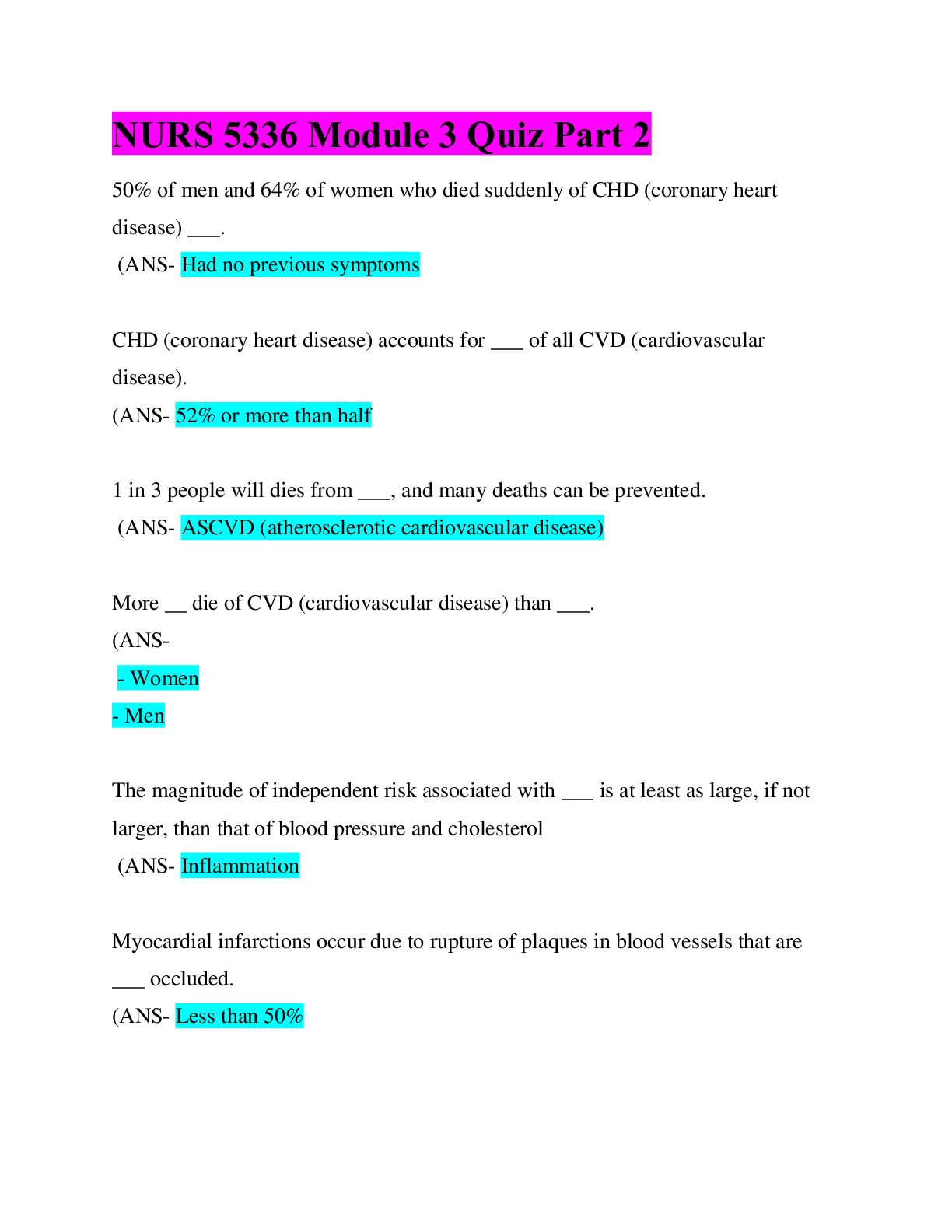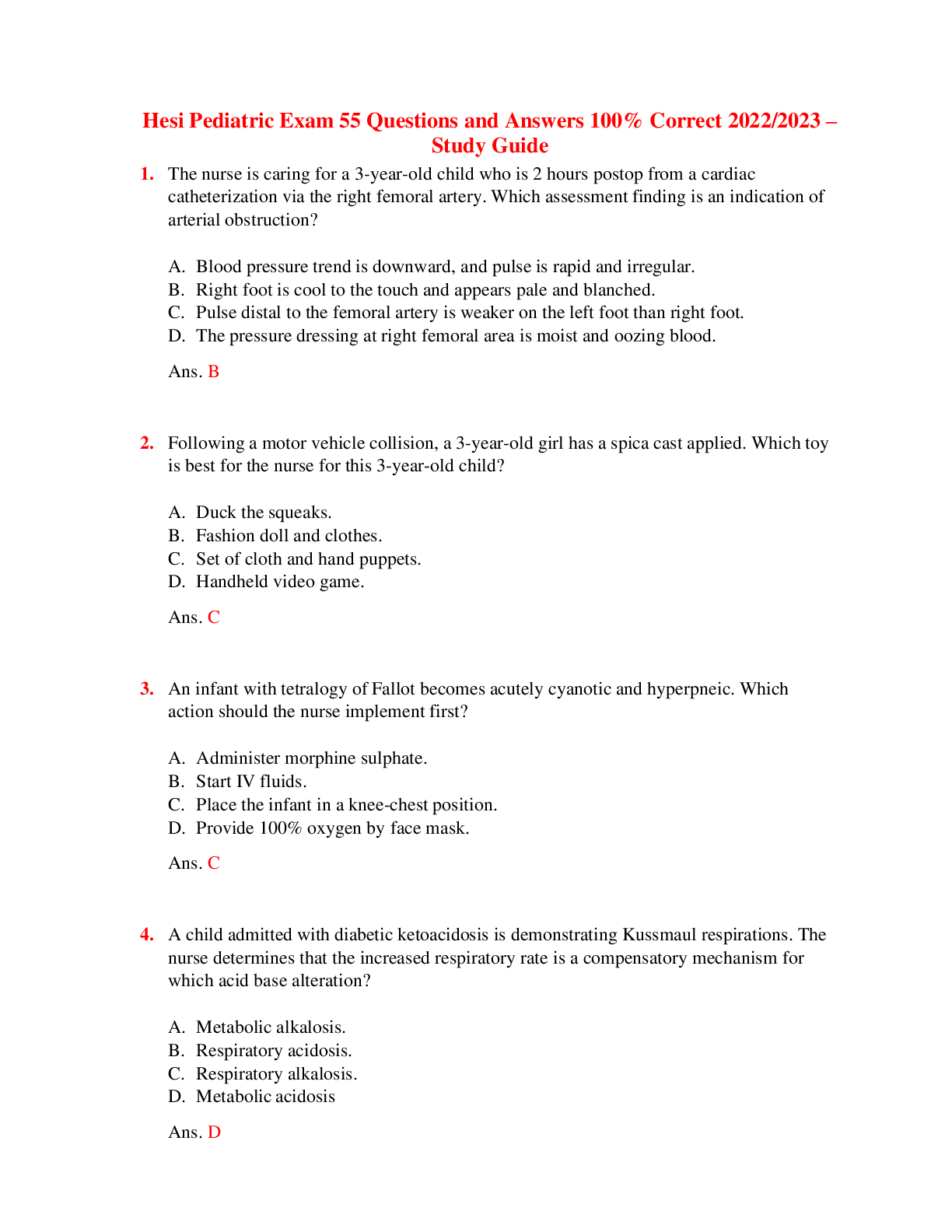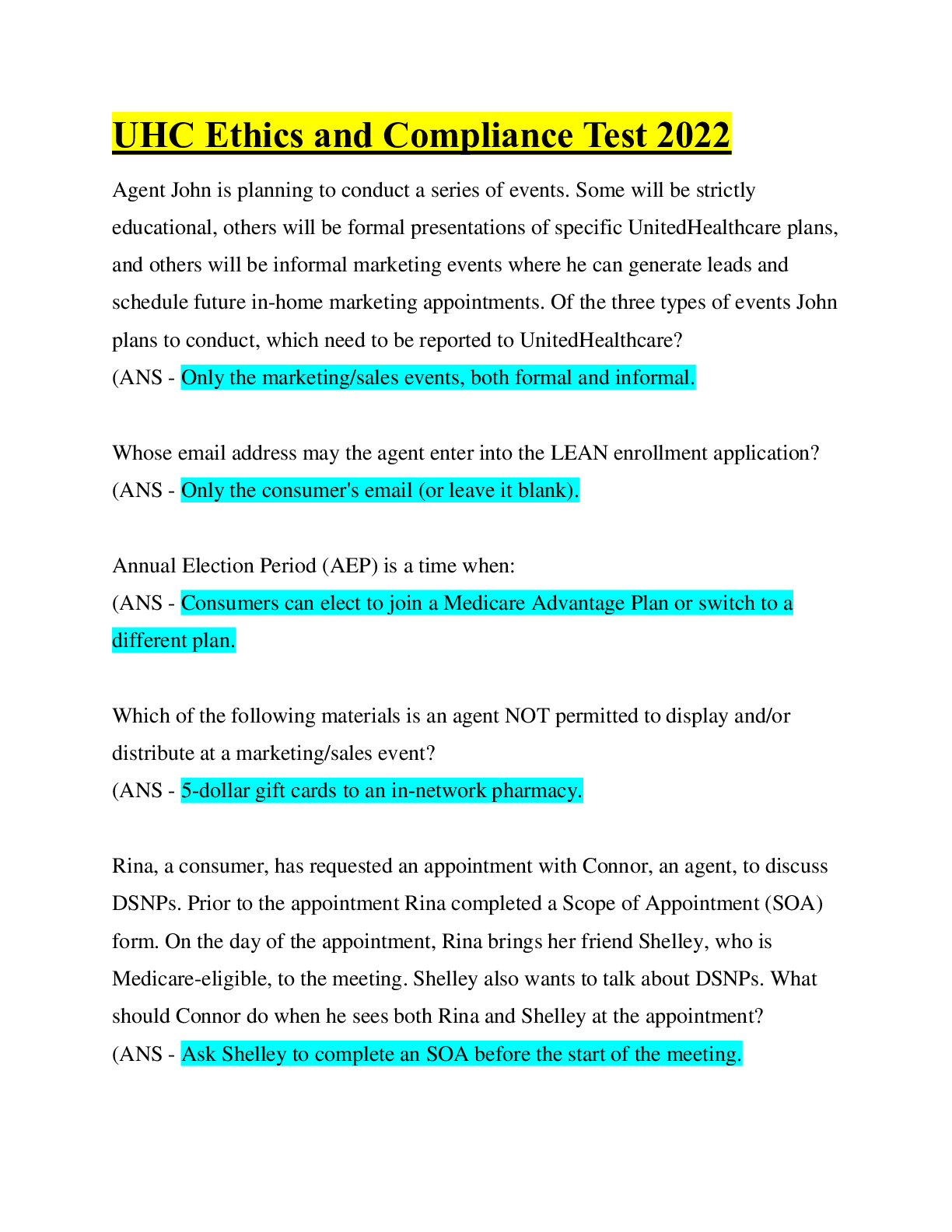Pharmacology > EXAM > ATI Pharmacology Proctored Test Bank. Questions & Answers 100% Correct (All)
ATI Pharmacology Proctored Test Bank. Questions & Answers 100% Correct
Document Content and Description Below
ATI Pharmacology Proctored Test Bank 1. 1) A nurse is caring for a client with hyperparathyroidism and notes that the client's serum calcium level is 13 mg/dL. Which medication should the nurse p... repare to administer as prescribed to the client? 1. Calcium chloride 2.Calcium gluconate 3.Calcitonin (Miacalcin) 4.Large doses of vitamin D 2. 2.) Oral iron supplements are prescribed for a 6-year-old child with iron deficiency anemia. The nurse instructs the mother to administer the iron with which best food item? 1. Milk 2.Water 3.Apple juice 4.Orange juice 3. 3.) Salicylic acid is prescribed for a client with a diagnosis of psoriasis. The nurse monitors the client, knowing that which of the following would indicate the presence of systemic toxicity from this medication? 1. Tinnitus 2.Diarrhea 3.Constipation 4.Decreased respirations 4. 4.) The camp nurse asks the children preparing to swim in the lake if they have applied sunscreen. The nurse reminds the children that chemical sunscreens are most effective when applied: 1. Immediately before swimming 2.15 minutes before exposure to the sun 3.Immediately before exposure to the sun 4.At least 30 minutes before exposure to the sun 5. 5.) Mafenide acetate (Sulfamylon) is prescribed for the client with a burn injury. When applying the medication, the client complains of local discomfort and burning. Which of the following is the most appropriate nursing action? 1. Notifying the registered nurse 2.Discontinuing the medication 3.Informing the client that this is normal 4.Applying a thinner film than prescribed to the burn site 3. Calcitonin (Miacalcin) Rationale: The normal serum calcium level is 8.6 to 10.0 mg/dL. This client is experiencing hypercalcemia. Calcium gluconate and calcium chloride are medications used for the treatment of tetany, which occurs as a result of acute hypocalcemia. In hypercalcemia, large doses of vitamin D need to be avoided. Calcitonin, a thyroid hormone, decreases the plasma calcium level by inhibiting bone resorption and lowering the serum calcium concentration. 4. Orange juice Rationale: Vitamin C increases the absorption of iron by the body. The mother should be instructed to administer the medication with a citrus fruit or a juice that is high in vitamin C. Milk may affect absorption of the iron. Water will not assist in absorption. Orange juice contains a greater amount of vitamin C than apple juice. 1. Tinnitus Rationale: Salicylic acid is absorbed readily through the skin, and systemic toxicity (salicylism) can result. Symptoms include tinnitus, dizziness, hyperpnea, and psychological disturbances. Constipation and diarrhea are not associated with salicylism. 4. At least 30 minutes before exposure to the sun Rationale: Sunscreens are most effective when applied at least 30 minutes before exposure to the sun so that they can penetrate the skin. All sunscreens should be reapplied after swimming or sweating. 3. Informing the client that this is normal Rationale: Mafenide acetate is bacteriostatic for gram-negative and gram-positive organisms and is used to treat burns to reduce bacteria present in avascular tissues. The client should be informed that the medication will cause local discomfort and burning and that this is a normal reaction; therefore options 1, 2, and 4 are incorrect 6. 6.) The burn client is receiving treatments of topical mafenide acetate (Sulfamylon) to the site of injury. The nurse monitors the client, knowing that which of the following indicates that a systemic effect has occurred? 1.Hyperventilation 2.Elevated blood pressure 3.Local pain at the burn site 4.Local rash at the burn site 7. 7.) Isotretinoin is prescribed for a client with severe acne. Before the administration of this medication, the nurse anticipates that which laboratory test will be prescribed? 1. Platelet count 2.Triglyceride level 3.Complete blood count 4.White blood cell count 8. 8.) A client with severe acne is seen in the clinic and the health care provider (HCP) prescribes isotretinoin. The nurse reviews the client's medication record and would contact the (HCP) if the client is taking which medication? 1. Vitamin A 2.Digoxin (Lanoxin) 3.Furosemide (Lasix) 4.Phenytoin (Dilantin) 9. 9.) The nurse is applying a topical corticosteroid to a client with eczema. The nurse would monitor for the potential for increased systemic absorption of the medication if the medication were being applied to which of the following body areas? 1. Back 2.Axilla 3.Soles of the feet 4.Palms of the hands 10. 10.) The clinic nurse is performing an admission assessment on a client. The nurse notes that the client is taking azelaic acid (Azelex). Because of the medication prescription, the nurse would suspect that the client is being treated for: 1. Acne 2.Eczema 3.Hair loss 4.Herpes simplex 1. Hypervent ilation Rationale: Mafenide acetate is a carbonic anhydrase inhibitor and can suppress renal excretion of acid, thereby causing acidosis. Clients receiving this treatment should be monitored for signs of an acid-base imbalance (hyperventilation). If this occurs, the medication should be discontinued for 1 to 2 days. Options 3 and 4 describe local rather than systemic effects. An elevated blood pressure may be expected from the pain that occurs with a burn injury. 2. Triglyceride level Rationale: Isotretinoin can elevate triglyceride levels. Blood triglyceride levels should be measured before treatment and periodically thereafter until the effect on the triglycerides has been evaluated. Options 1, 3, and 4 do not need to be monitored specifically during this treatment. 1. Vita min A Rationale: Isotretinoin is a metabolite of vitamin A and can produce generalized intensification of isotretinoin toxicity. Because of the potential for increased toxicity, vitamin A supplements should be discontinued before isotretinoin therapy. Options 2, 3, and 4 are not contraindicated with the use of isotretinoin. 2.Axilla Rationale : Topical corticosteroids can be absorbed into the systemic circulation. Absorption is higher from regions where the skin is especially permeable (scalp, axilla, face, eyelids, neck, perineum, genitalia), and lower from regions in which permeability is poor (back, palms, soles). 1. A cne Rationale : Azelaic acid is a topical medication used to treat mild to moderate acne. The acid appears to work by suppressing the growth of Propionibacterium acnes and decreasing the proliferation of keratinocytes. Options 2, 3, and 4 are incorrect. 11. 11.) The health care provider has prescribed silver sulfadiazine (Silvadene) for the client with a partial- thickness burn, which has cultured positive for gramnegative bacteria. The nurse is reinforcing information to the client about the medication. Which statement made by the client indicates a lack of understanding about the treatments? 1. "The medication is an antibacterial." 2."The medication will help heal the burn." 3."The medication will permanently stain my skin." 4. "The medication should be applied directly to the wound." 12. 12.) A nurse is caring for a client who is receiving an intravenous (IV) infusion of an antineoplastic medication. During the infusion, the client complains of pain at the insertion site. During an inspection of the site, the nurse notes redness and swelling and that the rate of infusion of the medication has slowed. The nurse should take which appropriate action? 1. Notify the registered nurse. 2.Administer pain medication to reduce the discomfort. 3.Apply ice and maintain the infusion rate, as prescribed. 4.Elevate the extremity of the IV site, and slow the infusion. 13. 13.) The client with squamous cell carcinoma of the larynx is receiving bleomycin intravenously. The nurse caring for the client anticipates that which diagnostic study will be prescribed? 1. Echocardiography 2.Electrocardiography 3.Cervical radiography 4.Pulmonary function studies 14. 14.) The client with acute myelocytic leukemia is being treated with busulfan (Myleran). Which laboratory value would the nurse specifically monitor during treatment with this medication? 1. Clotting time 2.Uric acid level 3.Potassium level 4.Blood glucose level 3. "The medication will permanently stain my skin." Rationale: Silver sulfadiazine (Silvadene) is an antibacterial that has a broad spectrum of activity against gram-negative bacteria, gram-positive bacteria, and yeast. It is applied directly to the wound to assist in healing. It does not stain the skin. 1. Notify the registered nurse. Rationale: When antineoplastic medications (Chemotheraputic Agents) are administered via IV, great care must be taken to prevent the medication from escaping into the tissues surrounding the injection site, because pain, tissue damage, and necrosis can result. The nurse monitors for signs of extravasation, such as redness or swelling at the insertion site and a decreased infusion rate. If extravasation occurs, the registered nurse needs to be notified; he or she will then contact the health care provider. 4. Pulmonary function studies Rationale: Bleomycin is an antineoplastic medication (Chemotheraputic Agents) that can cause interstitial pneumonitis, which can progress to pulmonary fibrosis. Pulmonary function studies along with hematological, hepatic, and renal function tests need to be monitored. The nurse needs to monitor lung sounds for dyspnea and crackles, which indicate pulmonary toxicity. The medication needs to be discontinued immediately if pulmonary toxicity occurs. Options 1, 2, and 3 are unrelated to the specific use of this medication. 2. Uric acid level Rationale: Busulfan (Myleran) can cause an increase in the uric acid level. Hyperuricemia can produce uric acid nephropathy, renal stones, and acute renal failure. Options 1, 3, and 4 are not specifically related to this medication. 15. 15.) The client with small cell lung cancer is being treated with etoposide (VePesid). The nurse who is assisting in caring for the client during its administration understands that which side effect is specifically associated with this medication? 1. Alopecia 2.Chest pain 3.Pulmonary fibrosis 4.Orthostatic hypotension 16. 16.) The clinic nurse is reviewing a teaching plan for the client receiving an antineoplastic medication. When implementing the plan, the nurse tells the client: 1. To take aspirin (acetylsalicylic acid) as needed for headache 2.Drink beverages containing alcohol in moderate amounts each evening 3.Consult with health care providers (HCPs) before receiving immunizations 4.That it is not necessary to consult HCPs before receiving a flu vaccine at the local health fair 17. 17.) The client with ovarian cancer is being treated with vincristine (Oncovin). The nurse monitors the client, knowing that which of the following indicates a side effect specific to this medication? 1. Diarrhea 2.Hair loss 3.Chest pain 4.Numbness and tingling in the fingers and toes 18. 18.) The nurse is reviewing the history and physical examination of a client who will be receiving asparaginase (Elspar), an antineoplastic agent. The nurse consults with the registered nurse regarding the administration of the medication if which of the following is documented in the client's history? 1. Pancreatitis 2.Diabetes mellitus 3.Myocardial infarction 4.Chronic obstructive pulmonary disease 4. Orthostatic hypotension Rationale: A side effect specific to etoposide is orthostatic hypotension. The client's blood pressure is monitored during the infusion. Hair loss occurs with nearly all the antineoplastic medications. Chest pain and pulmonary fibrosis are unrelated to this medication. 3. Consult with health care providers (HCPs) before receiving immunizations Rationale: Because antineoplastic medications lower the resistance of the body, clients must be informed not to receive immunizations without a HCP's approval. Clients also need to avoid contact with individuals who have recently received a live virus vaccine. Clients need to avoid aspirin and aspirin-containing products to minimize the risk of bleeding, and they need to avoid alcohol to minimize the risk of toxicity and side effects. 4. Numbness and tingling in the fingers and toes Rationale: A side effect specific to vincristine is peripheral neuropathy, which occurs in almost every client. Peripheral neuropathy can be manifested as numbness and tingling in the fingers and toes. Depression of the Achilles tendon reflex may be the first clinical sign indicating peripheral neuropathy. Constipation rather than diarrhea is most likely to occur with this medication, although diarrhea may occur occasionally. Hair loss occurs with nearly all the antineoplastic medications. Chest pain is unrelated to this medication. 1. Pancr eatitis Rationale: Asparaginase (Elspar) is contraindicated if hypersensitivity exists, in pancreatitis, or if the client has a history of pancreatitis. The medication impairs pancreatic function and pancreatic function tests should be performed before therapy begins and when a week or more has elapsed between administration of the doses. The client needs to be monitored for signs of pancreatitis, which include nausea, vomiting, and abdominal pain. The conditions noted in options 2, 3, and 4 are not contraindicated with this medication. 19. 19.) Tamoxifen is prescribed for the client with metastatic breast carcinoma. The nurse understands that the primary action of this medication is to: 1. Increase DNA and RNA synthesis. 2.Promote the biosynthesis of nucleic acids. 3.Increase estrogen concentration and estrogen response. 4.Compete with estradiol for binding to estrogen in tissues containing high concentrations of receptors. 20. 20.) The client with metastatic breast cancer is receiving tamoxifen. The nurse specifically monitors which laboratory value while the client is taking this medication? 1. Glucose level 2.Calcium level 3.Potassium level 4.Prothrombin time 21. 21.) A nurse is assisting with caring for a client with cancer who is receiving cisplatin. Select the adverse effects that the nurse monitors for that are associated with this medication. Select all that apply. 1. Tinnitus 2.Ototoxicity 3.Hyperkalemia 4.Hypercalcemia 5.Nephrotoxicity 6.Hypomagnesemia 22. 22.) A nurse is caring for a client after thyroidectomy and notes that calcium gluconate is prescribed for the client. The nurse determines that this [Show More]
Last updated: 1 year ago
Preview 1 out of 63 pages
Instant download

Instant download
Reviews( 0 )
Document information
Connected school, study & course
About the document
Uploaded On
Apr 13, 2021
Number of pages
63
Written in
Additional information
This document has been written for:
Uploaded
Apr 13, 2021
Downloads
0
Views
57

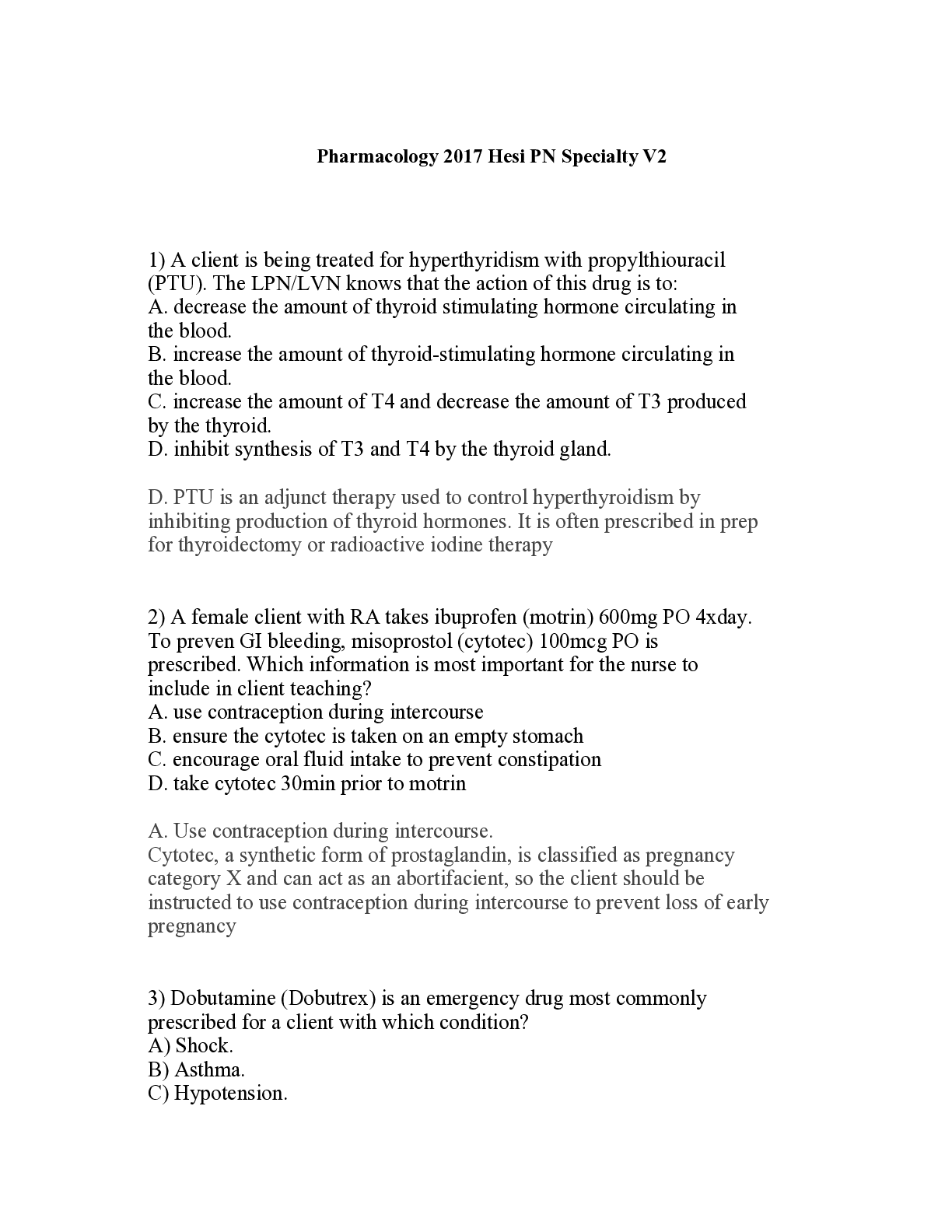
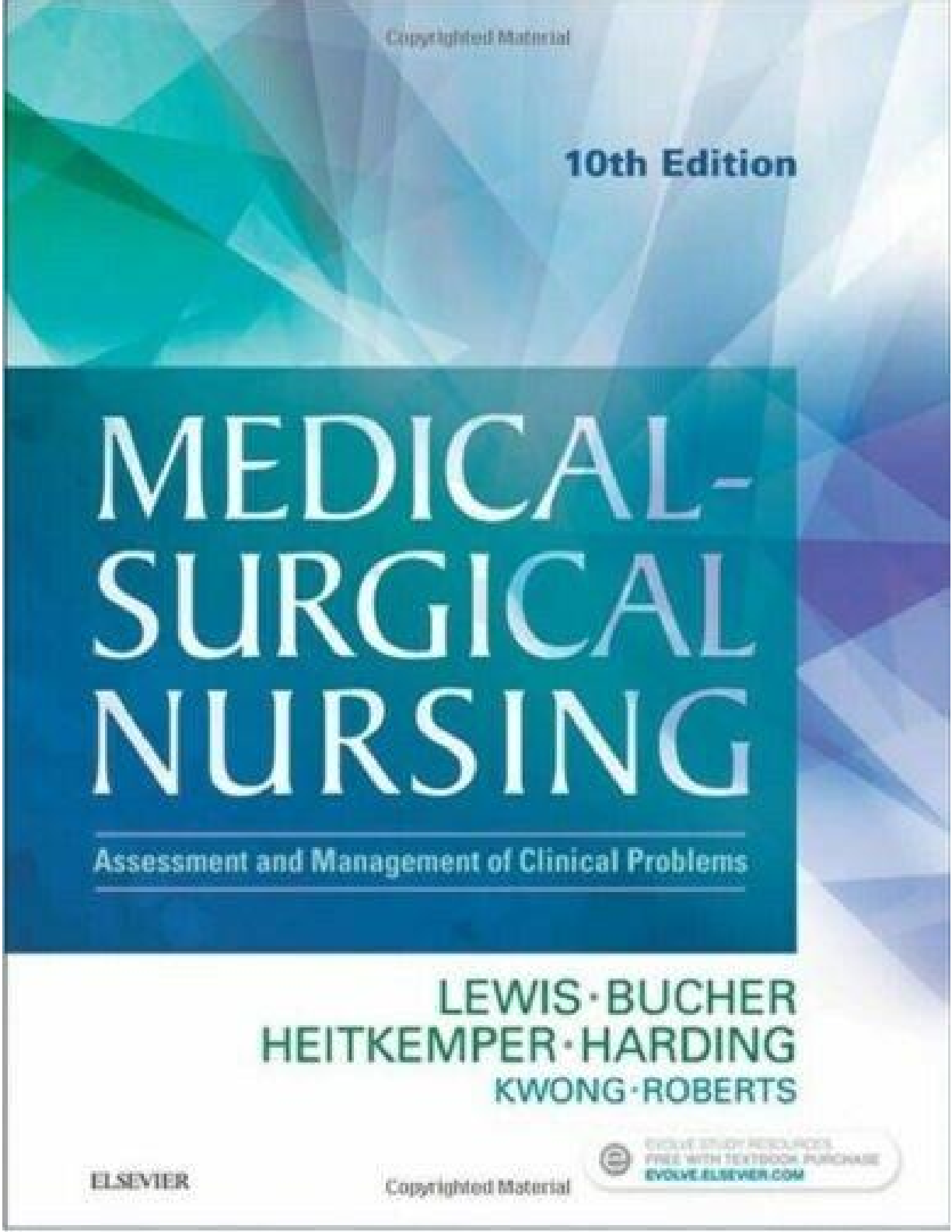
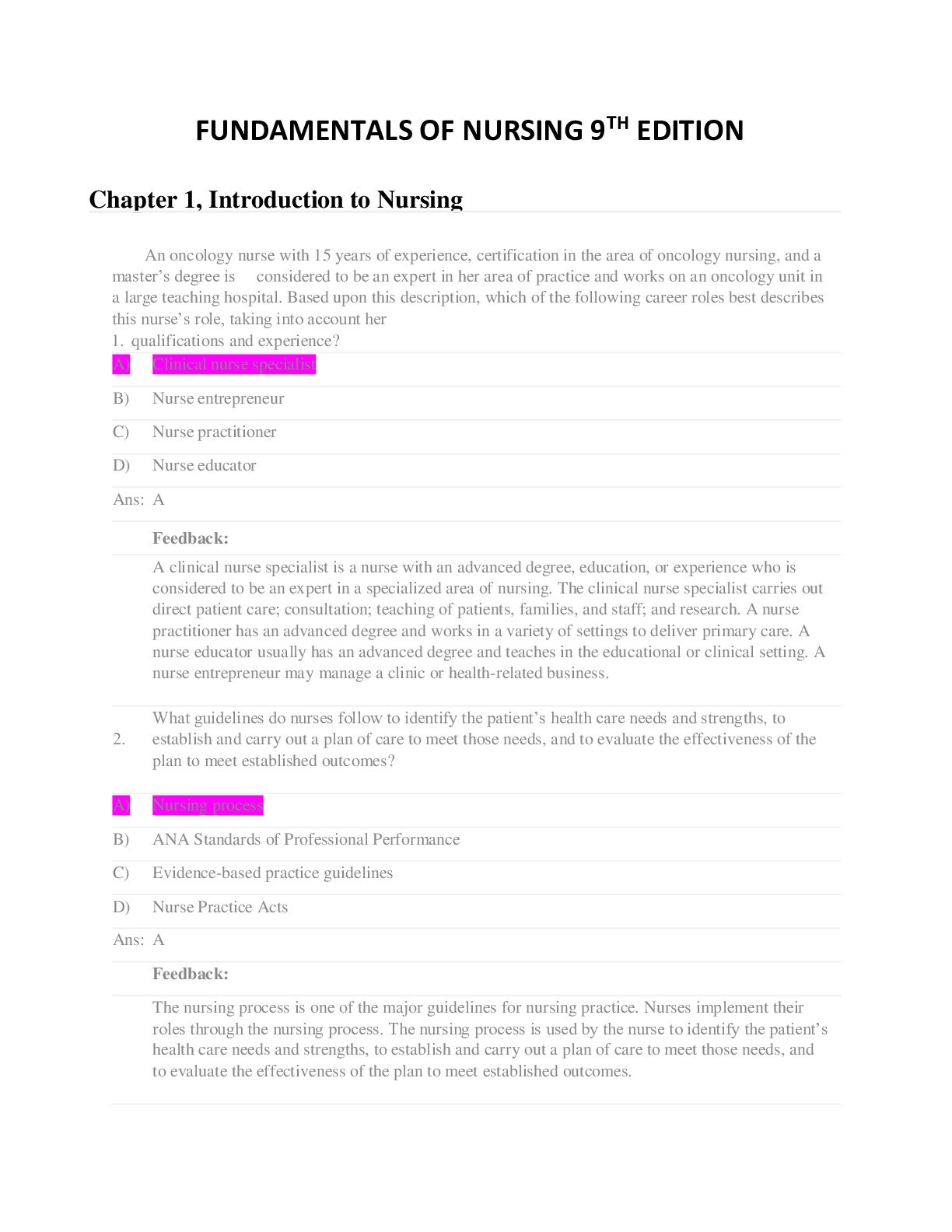
.png)

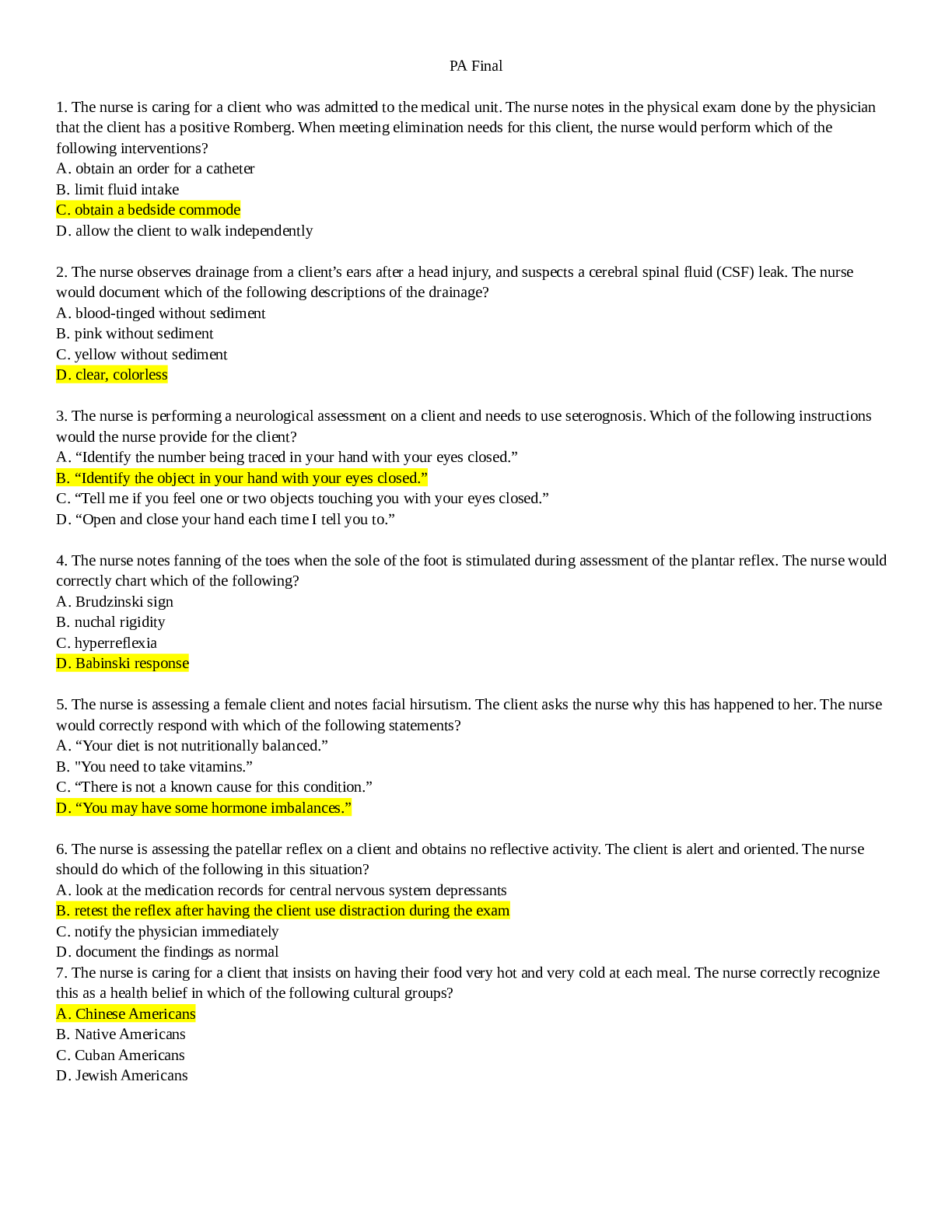


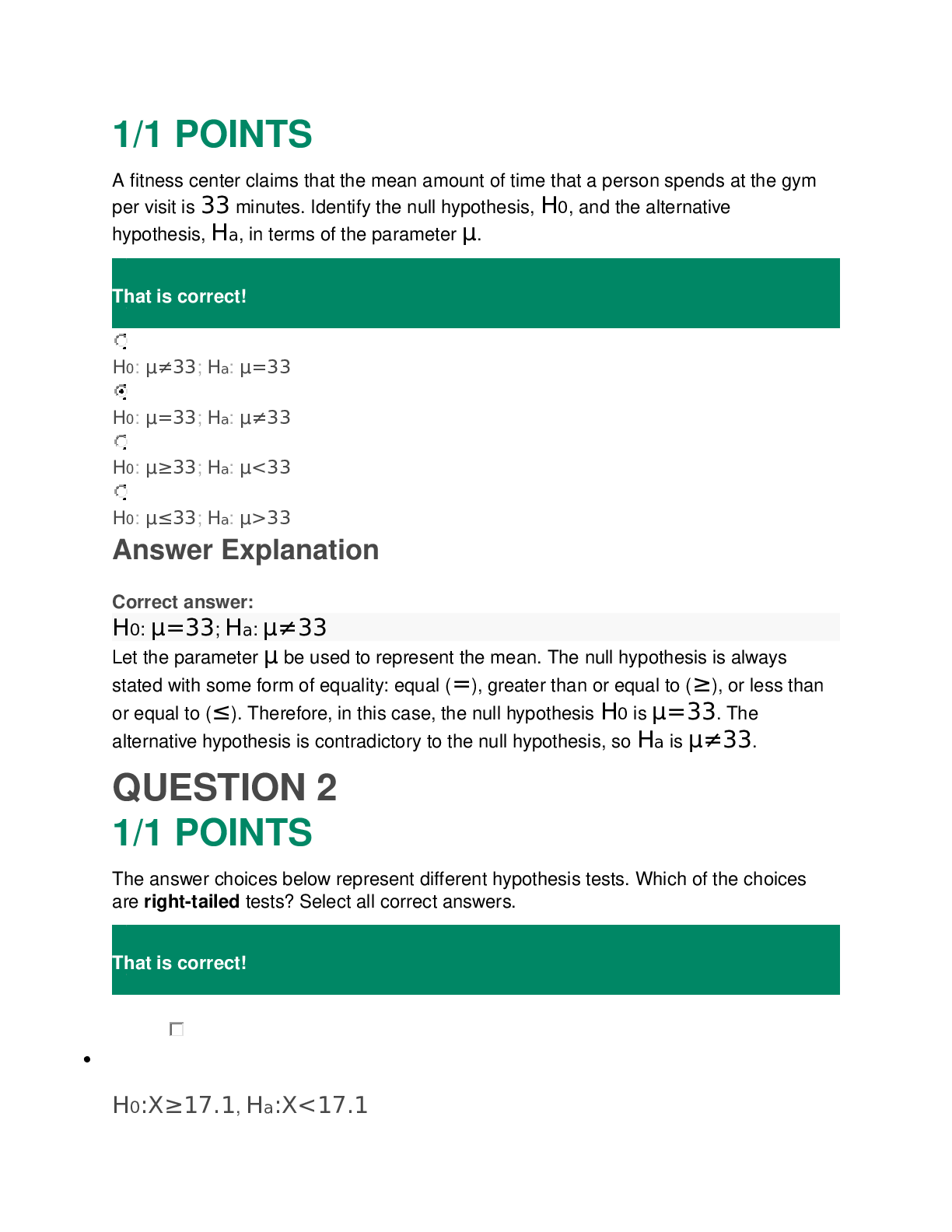
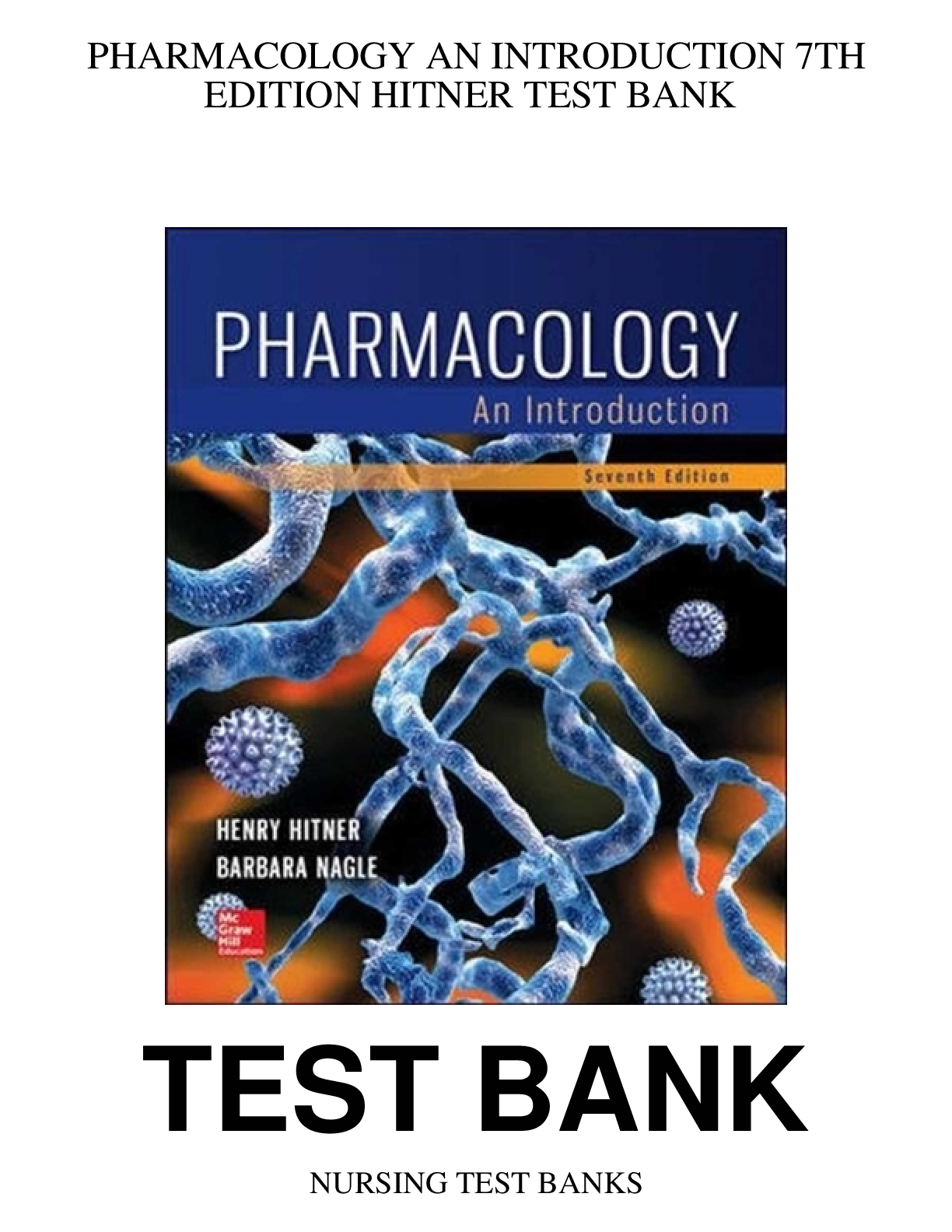


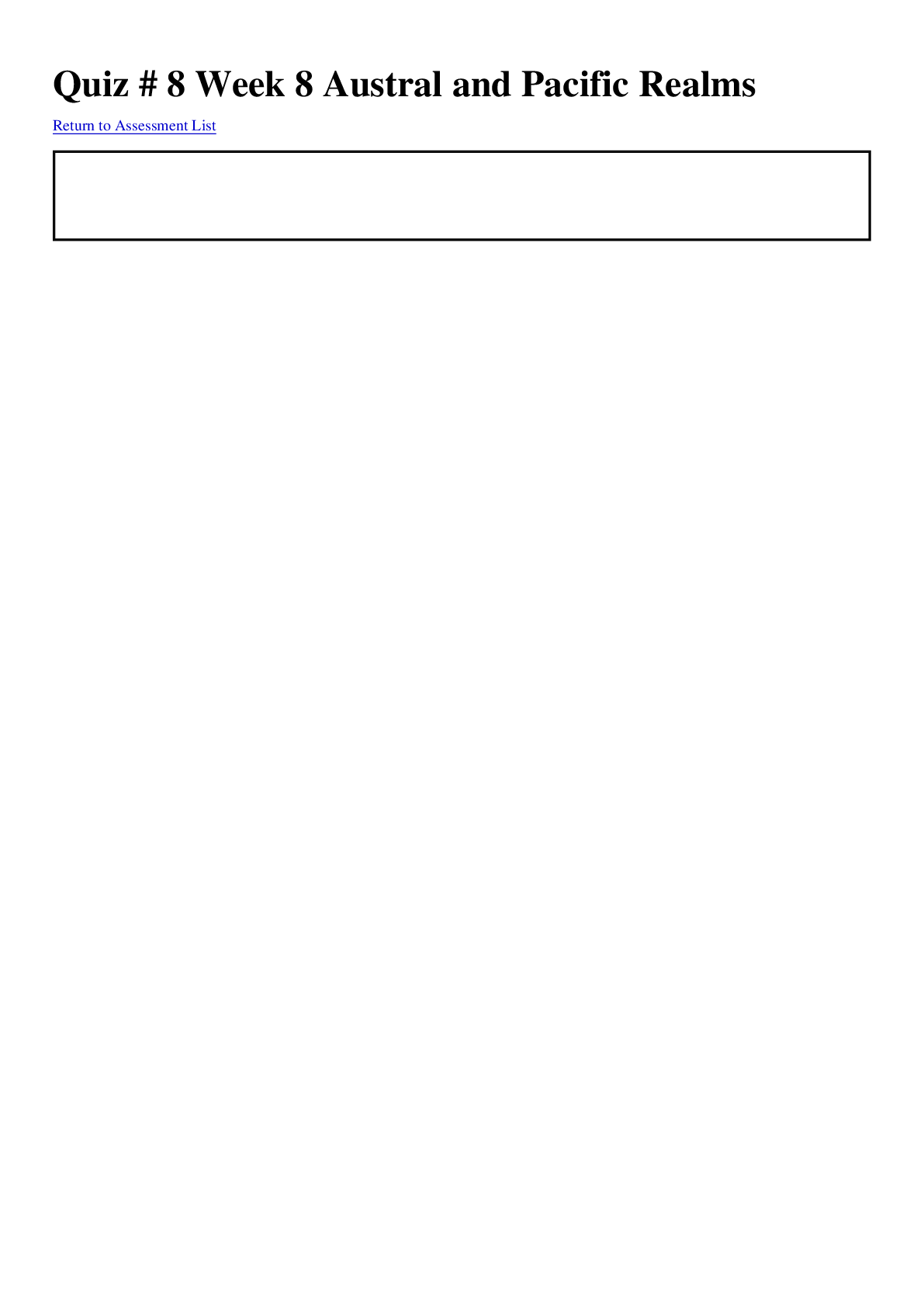


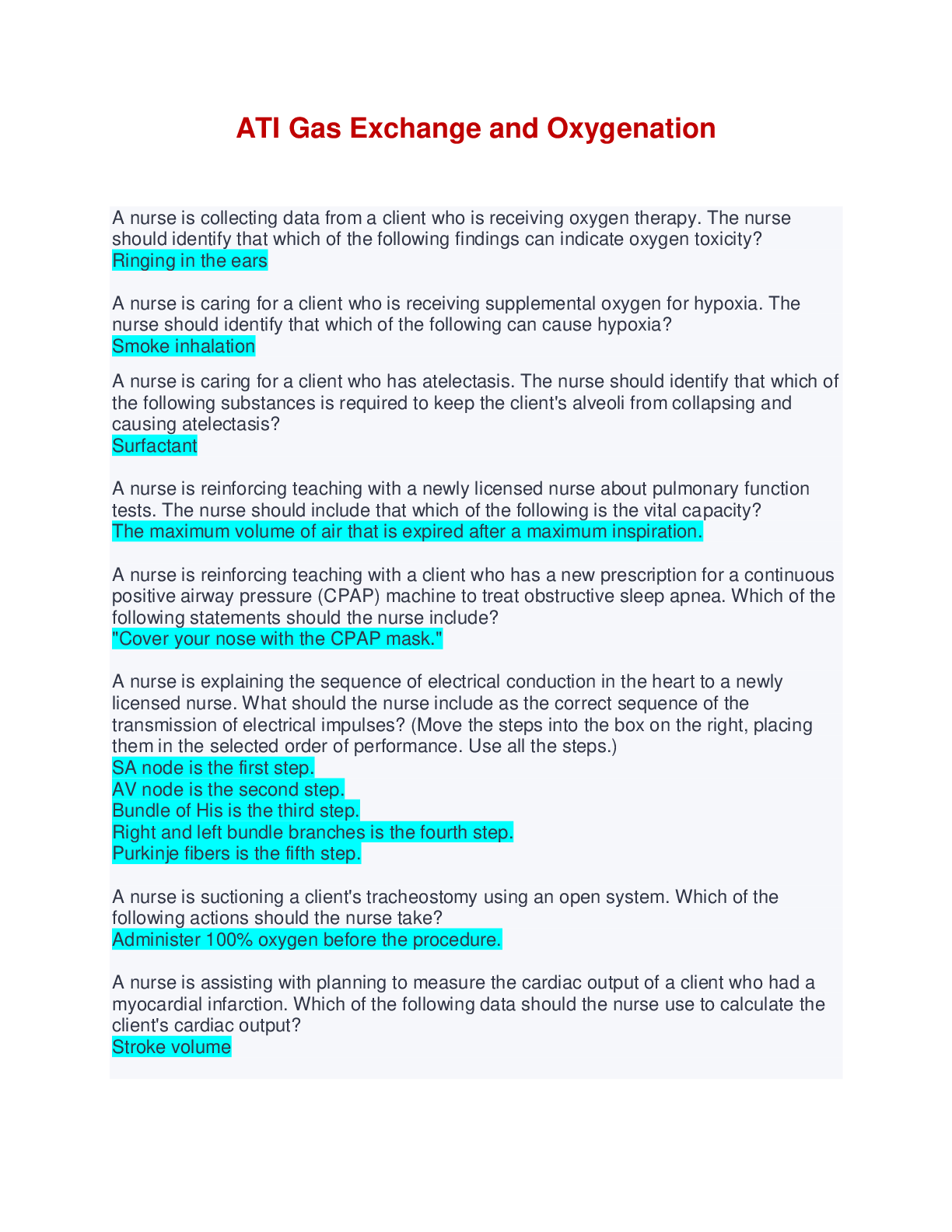
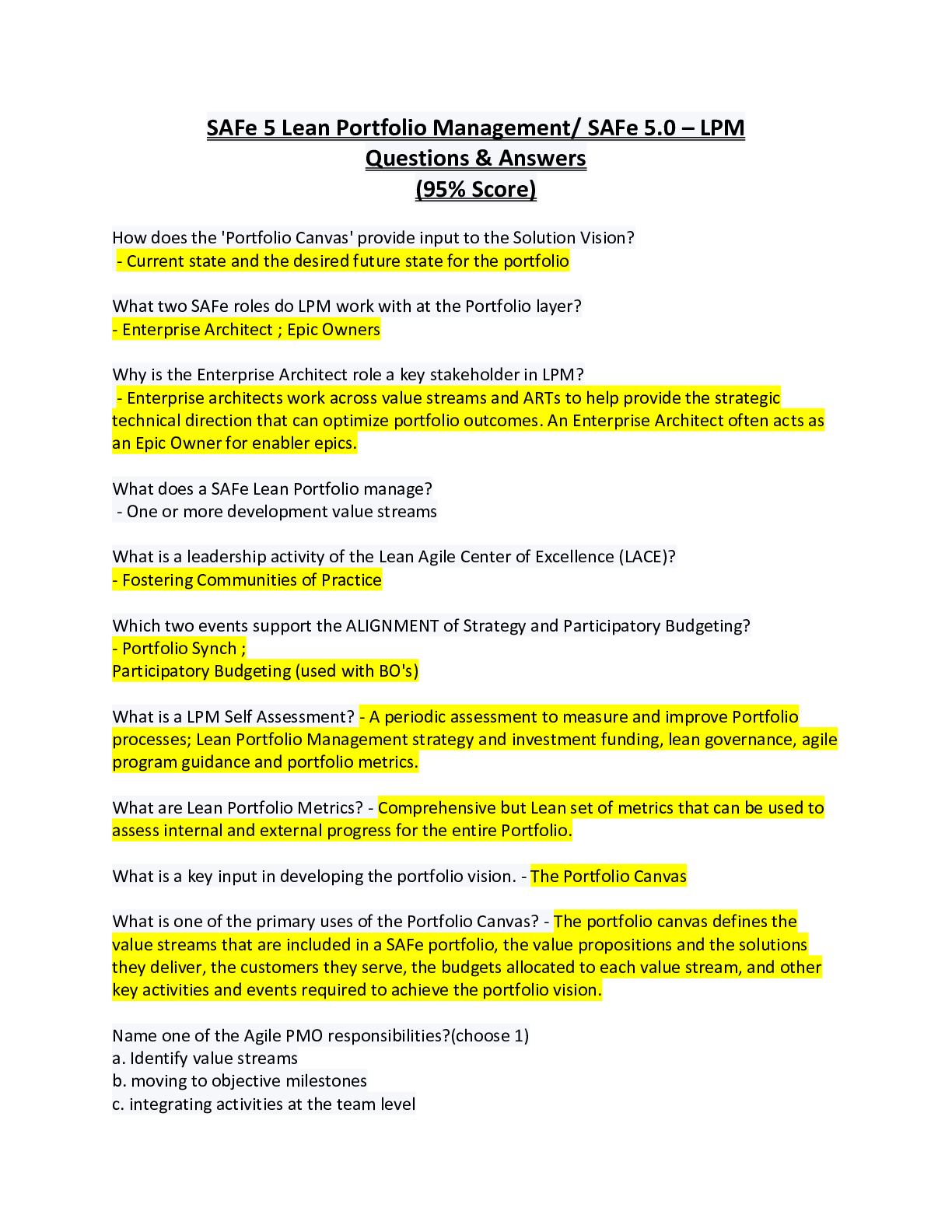





.png)



